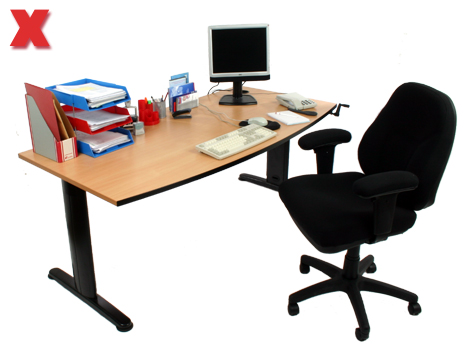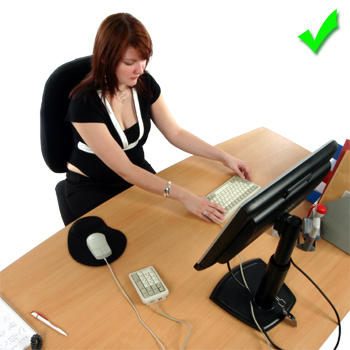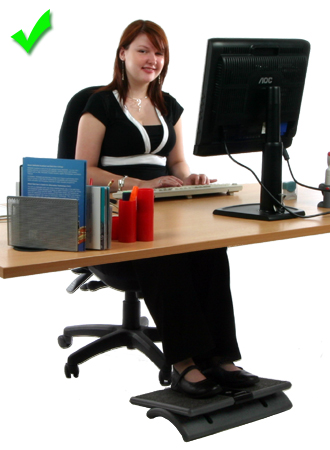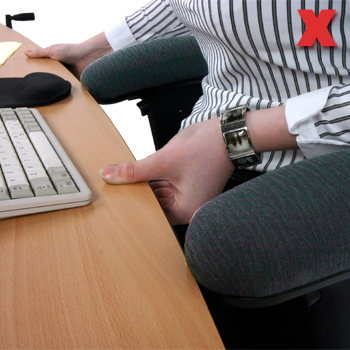 Desk.
Desk.


Above: Typical computer desk with monitor to the right hand side.
Introduction.

Above: Having clear space on the desktop enables the user to move equipment around in order
to get into a more comfortable position.
Remember the user may need to write, type, read and use the phone, so there must be room for papers and equipment without the user twisting the neck or back for any sustained period or having to lean forwards or back. Maintaining good posture is all important. The desk should also have a low reflective surface to minimise glare and be a suitable height, generally between 580-790mm.
Top tips.
- Large enough surface for DSE components and work related activities.
- The area beneath the desk should be free of clutter to allow sufficient legroom / thigh clearance .
- Items used frequently should be placed within easy reach to avoid unnecessary stretching.
Position.

Above: A footrest should be used as and when required.
- aim to sit upright with a natural curve in the spine.
- shoulders should be relaxed with the upper arms by your side and the forearms parallel with the elbows at approximately a 90 degree angle.
- wrists should be in a neutral position with the fingers positioned above the home keys.
- knees should be lower than the pelvis.
- feet should be placed firmly on the floor or on a footrest.
- check nothing prevents sitting correctly with the spine straight, not twisted.
- check nothing gets in the way of natural leg stretching or position.
- check nothing prevents the chair swivelling freely.
Type and style.

Above: Chair arms can prevent you from getting close enough to your desk for comfort.
- A standard rectangular desk of a suitable height, length and depth will be adequate for most users.
- L-shaped desks are popular as the corner section provides greater depth to accommodate larger screens. Ideally the front should curve outwards to accommodate the keyboard and prevent the user over-stretching.
- If there is an unsuitable gap, consider a corner insert so that the keyboard can be positioned closer.
Other issues to look out for:
- the armrests of the chair meet the front of the desk, so users can't sit close enough.
- the desk has a short return on the same side as the user's dominant hand, leaving little room for phone or paper.
- the pedestal or PC tower is underneath the straight section preventing the user from easily moving their chair.
- avoid desks with fixed drawer units that can prevent leg movement.
- an L-shape desk made up of two desks put together, with the legs restricting chair movement and legroom.
- desks that have been joined where the surface is not totally flat, the keyboard isn't stable and the mouse cannot work correctly.
- trolley style desks designed to accommodate all the DSE components with a pull out keyboard shelf providing insufficient legroom for the user to be able to sit correctly or adequate space for a flexible arrangement of equipment.
- desks with fixed drawer units that can prevent leg movement.
Usage and Activities.

Above: Compact keyboard with contour mouse and headset, providing a more flexible working environment.
- Provide adequate space for the different types of activities such as operating the computer, reading and writing.
- Where writing is a totally separate activity to that of operating the computer ensure a separate area of the desk for writing or the ability to easily move the keyboard/mouse to one side.
- For jobs with a combination of handwriting, keyboard and mouse use it's likely users will operate the mouse with the same hand they write with, and both mouse and paper need to take up the same area to the side of the keyboard.
- To overcome this consider a more flexible arrangement by using an alternative pointing device or swapping the mouse over so that it can be operated with the other hand.